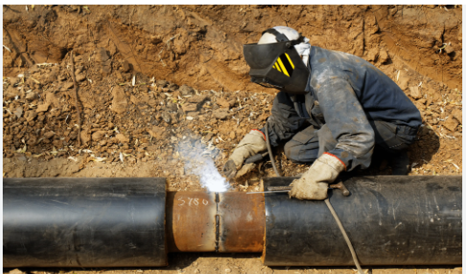This article explains Pipeline welding, types of Pipeline welding and Importance of pipeline welding in the oil and gas industry.
Introduction
Welding is the process of connecting two metal objects through heat, pressure, or both. High-pressure gas distribution networks usually use steel pipes and the quality of the welding is critical for the safety of the gas line since the welding joints are the weakest point of the gas line. Because of that, gas pipe welders take intensive training to obtain certificates that give them the license to perform welding on pipelines. Not every type of welding can be used on gas lines, just as not every welder is suitable for working on gas lines.
What is Pipeline Welding?
Pipeline Welding is also known as girth welding, pipeline welding is a type of fabrication process used to assemble pipes and form a network. Pipeline welders utilize flame torches, shielded metal, and tungsten arcs to form these pieces of metal. Pipeline welding requires a specialized set of skills and knowledge, as welders must be able to weld in various positions and environments, often working in remote locations and extreme weather conditions. They must also be knowledgeable in pipeline construction and maintenance procedures, as well as relevant safety regulations and standards.
Read: Gas Utilization Projects, Pipeline Projects and Investment Opportunities in Nigeria
Types Of Pipeline Welding?
The following welding procedures are usually done in pipelines:
Shielded Metal Arc Welding (SMAW): known as Manual Metal Arc Welding (MMA or MMAW), Flux Shielded Arc Welding or Stick Welding. Also known as stovepipe welding, using SMAW for pipe welding means that no flux or shielding gas are needed during welding, making the welding equipment simple and portable. The metal is welded by melting the electrodes through the heat generated by an electric arc.
Gas Metal Arc Welding (GMAW): Gas Metal Arc Welding (GMAW) including Metal Inert Gas (MIG) Welding and Metal Active Gas (MAG) Welding. Offering greater productivity than with SMAW, these techniques do require better control of the welding variables to deliver high quality, efficient work. Usually performed with semi or fully automatic equipment, GMAW offers high deposition rates with low fume generation.
Flux-Cored Arc Welding (FCAW): Flux-Cored Arc Welding (FCAW) – including self-shielded and gas-shielded FCAW. Gas-shielded FCAW uses semi-automatic machines to provide a high productivity welding solution for pipes, although windy conditions can disturb the shielding gas and lead to porosity defects. Self-shielded FCAW avoids this by not requiring a shielding gas, but has lower deposition rates.
Submerged Arc Welding (SAW): In semi-automatic Submerged Arc Welding (SAW), the electric arc forms between the workpiece and the continuously fed electrode. Tracing becomes more difficult since the arc is not visible. On the contrary, it produces flawless surfaces as compared to other pipeline welding methods. Each technique has its own advantages and disadvantages, and the choice of technique will depend on the specific requirements of the
Tungsten Inert Gas (TIG) Welding: TIG welding is used for welding critical joints requiring precision welds as this method produces high-quality pipeline welding utilizing tungsten electrodes. But, welding of pipelines by gas tungsten arc welding has lower deposition rates and higher equipment costs. (TIG) welding is also known as Tungsten Inert Gas (TIG) Welding also known as Gas Tungsten Arc Welding (GTAW).
Read: HYDROCARBON GAS LIQUIDS/Definition/Types/Facts
Importance Of Pipeline Welding in The Oil and Gas Industry
Welding plays an indispensable role, forming the very infrastructure that facilitates energy extraction, processing, and distribution. From upstream exploration to downstream refinement and distribution, welding processes are critical at every stage
Upstream Welding: Exploration and Production
In the upstream sector, where energy extraction takes place, welding operations must contend with harsh conditions, including extreme temperatures, corrosive substances, and high-pressure environments. Processes such as Shielded Metal Arc Welding (SMAW), Gas Metal Arc Welding (GMAW) and Gas Tungsten Arc Welding (GTAW) are commonly employed for their ability to withstand these conditions.
Midstream Welding: Transportation and Storage:
In the midstream sector, which involves transportation and storage, welding plays a pivotal role in constructing pipelines, storage tanks, and terminals. Here, processes like Gas Metal Arc Welding (GMAW) and Electroslag Welding (ESW) are favored for their efficiency and suitability for large-scale projects. Pipeline construction demands precision welding to guarantee leak-proof joints and structural integrity over vast distances and varied terrain. Additionally, the integration of automated welding technologies enhances productivity while maintaining consistency and quality throughout the project lifecycle.
Downstream Welding: Refinement and Distribution
Downstream operations encompass the refining of raw resources into usable energy products and their subsequent distribution. Refinery construction requires meticulous welding to assemble complex processing units, such as distillation columns and reactors, which endure high temperatures and corrosive substances. Piping systems within refineries and distribution networks are lifelines that transport fuels and chemicals safely and efficiently. Weld quality and integrity are paramount to prevent leaks, spills, and catastrophic failures that could jeopardize human safety and environmental sustainability. Non-destructive testing (NDT) methods, including radiographic testing and ultrasonic inspection, are indispensable tools for identifying defects and ensuring compliance with industry standards.

